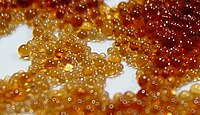 Global Information
Global InformationIon exchange information


Ion exchange is a reversible interchange of one species of ion present in an insoluble solid with another of like charge present in a solution surrounding the solid. Ion exchange is used in softening or demineralizing of water, purification of chemicals, and separation of substances.
Ion exchange usually describes a process of purification of aqueous solutions using solid polymeric ion-exchange resin. More precisely, the term encompasses a large variety of processes where ions are exchanged between two electrolytes.[1] Aside from its use to purify drinking water, the technique is widely applied for purification and separation of a variety of industrially and medicinally important chemicals. Although the term usually refers to applications of synthetic (human-made) resins, it can include many other materials such as soil.
Typical ion exchangers are ion-exchange resins (functionalized porous or gel polymer), zeolites, montmorillonite, clay, and soil humus. Ion exchangers are either cation exchangers, which exchange positively charged ions (cations), or anion exchangers, which exchange negatively charged ions (anions). There are also amphoteric exchangers that are able to exchange both cations and anions simultaneously. However, the simultaneous exchange of cations and anions is often performed in mixed beds, which contain a mixture of anion- and cation-exchange resins, or passing the solution through several different ion-exchange materials.

Ion exchangers can have binding preferences for certain ions or classes of ions, depending on the physical properties and chemical structure of both the ion exchanger and ion. This can be dependent on the size, charge, or structure of the ions. Common examples of ions that can bind to ion exchangers are:
- H+ (proton) and OH− (hydroxide).
- Singly charged monatomic (i.e., monovalent) ions like Na+, K+, and Cl−.
- Doubly charged monatomic (i.e., divalent) ions like Ca2+ and Mg2+.
- Polyatomic inorganic ions like SO2−
4 and PO3−
4. - Organic bases, usually molecules containing the amine functional group −NR2H+.
- Organic acids, often molecules containing −COO− (carboxylic acid) functional groups.
- Biomolecules that can be ionized: amino acids, peptides, proteins, etc.
Along with absorption and adsorption, ion exchange is a form of sorption.
Ion exchange is a reversible process, and the ion exchanger can be regenerated or loaded with desirable ions by washing with an excess of these ions.

- ^ Dardel, François; Arden, Thomas V. (2008). "Ion Exchangers". Ullmann's Encyclopedia of Industrial Chemistry. Weinheim: Wiley-VCH. doi:10.1002/14356007.a14_393.pub2. ISBN 978-3527306732.